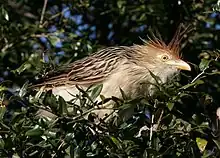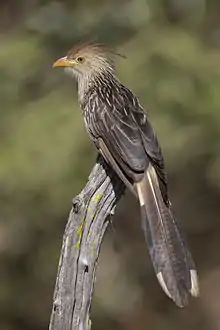Crotophaginae
The Crotophaginae are a small subfamily, within the cuckoo family Cuculidae, of four gregarious bird species occurring in the Americas. They were previously classified as a family Crotophagidae.
| Crotophagines | |
|---|---|
 | |
| Guira cuckoo, Guira guira | |
| Scientific classification | |
| Domain: | Eukaryota |
| Kingdom: | Animalia |
| Phylum: | Chordata |
| Clade: | Dinosauria |
| Class: | Aves |
| Order: | Cuculiformes |
| Family: | Cuculidae |
| Subfamily: | Crotophaginae Swainson, 1837 |
| Type species | |
| Crotophaga ani | |
| Genera | |
The subfamily is notable for the development of cooperative breeding where several females lay eggs in a communal nest.[2] It contains the three anis and the guira cuckoo.
Among the anis, there is considerable variation in nesting habits. One species, The greater ani (Crotophaga major) lays 2 or 3 eggs, while the groove-billed ani (C. sulcirostris) lays seven. However the smooth-billed ani (C. ani) will share one nest between several females, with up to 29 eggs in one nest. Incubation takes 15 days for this species.
Systematics
Four species make up the subfamily, namely the guira cuckoo (Guira guira) and the three members of the genus Crotophaga known as anis. Study of the cranial osteology and mitochondrial DNA yield the same phylogeny, namely that the Smooth-billed and groove-billed ani are each other's closest relatives, with the greater ani related and the guira cuckoo an earlier offshoot of the group.[3][4]
| Image | Genus | Living Species |
|---|---|---|
 | Guira Lesson, 1830 |
|
_(14646807502).jpg.webp) | Crotophaga Linnaeus, 1758 |
|
Distribution and habitat
The members of the family range from Florida in the north, through Central America and the West Indies and through South America south to Rio Negro in Argentina, in open habitats.[2]
References
- Brodkorb (1971). "Catalogue of fossil birds: part 4 (Columbiformes through Piciformes)". Bulletin of the Florida State Museum. 15: 163–266.
- Davis, David E. (1942). "The Phylogeny of Social Nesting Habits in the Crotophaginae". The Quarterly Review of Biology. 17 (2): 115–34. doi:10.1086/394650. JSTOR 2808549.
- Posso, Sergio R.; Donatelli, Reginaldo J. (2001). "Cranial osteology and systematic implications in Crotophaginae (Aves, Cuculidae)". Journal of Zoological Systematics and Evolutionary Research. 39 (4): 247–56. doi:10.1046/j.1439-0469.2001.00178.x.
- Hughes, Janice M. (2003). "Phylogeny of cooperatively breeding cuckoos (Cuculidae, Crotophaginae) based on mitochondrial gene sequences". Naturwissenschaften. 90 (5): 231–33. doi:10.1007/s00114-003-0413-8. PMID 12743706.